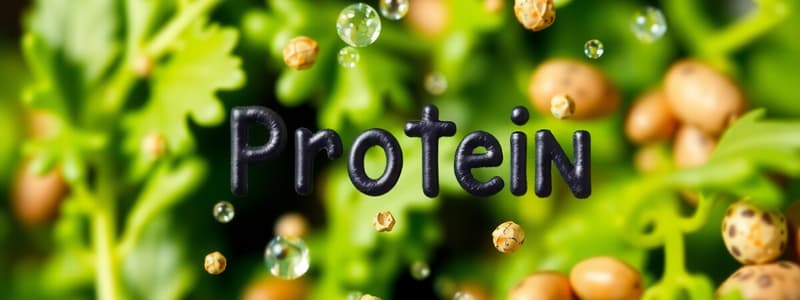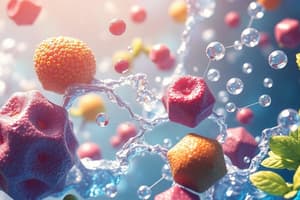Podcast
Questions and Answers
Which of the following is the primary role of proteins in the body?
Which of the following is the primary role of proteins in the body?
- Forming new cells and rebuilding tissues. (correct)
- Providing a quick source of energy.
- Storing genetic information.
- Regulating body temperature.
What compositional element distinguishes proteins from carbohydrates and fats?
What compositional element distinguishes proteins from carbohydrates and fats?
- Hydrogen
- Carbon
- Oxygen
- Nitrogen (correct)
What is the fundamental unit forming proteins?
What is the fundamental unit forming proteins?
- Glucose molecules
- Nucleotides
- Fatty acids
- Amino acids (correct)
What chemical groups are found in every amino acid?
What chemical groups are found in every amino acid?
What type of linkage connects amino acids in a protein?
What type of linkage connects amino acids in a protein?
Why are some amino acids classified as 'essential'?
Why are some amino acids classified as 'essential'?
Which of the following is true regarding non-essential amino acids?
Which of the following is true regarding non-essential amino acids?
What is a characteristic of complete proteins?
What is a characteristic of complete proteins?
Why is combining different plant foods important for obtaining high-quality proteins?
Why is combining different plant foods important for obtaining high-quality proteins?
What is the effect of cooking on proteins?
What is the effect of cooking on proteins?
What bodily function do plasma proteins serve?
What bodily function do plasma proteins serve?
What role do antibodies play in the human body?
What role do antibodies play in the human body?
How do proteins provide energy to the body?
How do proteins provide energy to the body?
What happens to excess protein that is not needed for body functions?
What happens to excess protein that is not needed for body functions?
How is the protein content of food estimated?
How is the protein content of food estimated?
What happens after the digestion of protein reaches to the small intestine?
What happens after the digestion of protein reaches to the small intestine?
Which of the following are the end products of the metabolism of amino acid?
Which of the following are the end products of the metabolism of amino acid?
How Proteins are classified by structure?
How Proteins are classified by structure?
What does nitrogen balance mean?
What does nitrogen balance mean?
What causes protein calorie malnutrition (PCM)?
What causes protein calorie malnutrition (PCM)?
Flashcards
What are Proteins?
What are Proteins?
Proteins are large, complex organic compounds made of carbon, hydrogen, oxygen, and nitrogen. Nitrogen distinguishes proteins from carbohydrates and fats.
Amino Acids
Amino Acids
The basic unit from which proteins are built is the amino acid. Each amino acid contains COOH or acid group and an amino acid group (NH2) or basic group.
Essential Amino Acids
Essential Amino Acids
Those amino acids which cannot be synthesized in sufficient amounts by the body and must be provided by the diet.
Non-Essential Amino Acids
Non-Essential Amino Acids
Signup and view all the flashcards
Classification of Proteins
Classification of Proteins
Signup and view all the flashcards
Complete Proteins
Complete Proteins
Signup and view all the flashcards
Amino Acid Functions
Amino Acid Functions
Signup and view all the flashcards
Proteins as Energy
Proteins as Energy
Signup and view all the flashcards
Protein Quality
Protein Quality
Signup and view all the flashcards
Biological Value (BV)
Biological Value (BV)
Signup and view all the flashcards
Improves Protein Quality
Improves Protein Quality
Signup and view all the flashcards
Animal Sources of Protein
Animal Sources of Protein
Signup and view all the flashcards
Plant Sources of Protein
Plant Sources of Protein
Signup and view all the flashcards
Protein Needs: Children
Protein Needs: Children
Signup and view all the flashcards
Protein Needs: Adults
Protein Needs: Adults
Signup and view all the flashcards
Protein Synthesis
Protein Synthesis
Signup and view all the flashcards
Amino Acid Absorption
Amino Acid Absorption
Signup and view all the flashcards
Amino Acid Metabolism Products
Amino Acid Metabolism Products
Signup and view all the flashcards
Study Notes
- Proteins are the basic building block of every living cell and essential for growth, repair, and maintenance of health.
- Proteins contain carbon, hydrogen, oxygen, and nitrogen, distinguishing them from carbohydrates and fats.
Objectives
- The importance of proteins in our daily diet should be appreciated
- The difference between complete and incomplete proteins should be understood
- The chemical nature of proteins should be described
- The importance of including proteins of high biological value in meals should be understood.
- Rich sources of proteins should be listed
- Knowledge about novel sources of proteins available in the market should be acquired
Definition
Composition
- Proteins consists of chains of amino acids linked by peptide bonds.
- Amino acids contain a carboxyl group (COOH) and an amino group (NH2).
Classification
- Essential amino acids cannot be synthesized in sufficient amounts by the body and must be obtained through diet.
- Adults require eight essential amino acids, while growing children require ten.
- Non-essential amino acids are required for tissue synthesis and repair but can be synthesized by the body.
Digestion and Metabolism
Protein Quality
- The proteins that make up skin, bones, muscles, hair, and nails in the body vary.
- Egg, milk, meat, and pulse proteins differ in quality and quantity.
- Protein content in food is estimated by measuring nitrogen content, with 16% nitrogen in proteins..
Classification by Quality
- Complete proteins contain all essential amino acids in amounts to meet the body's needs.
- Partially complete proteins have one or more essential amino acids in inadequate amounts.
- Incomplete proteins cannot support growth or repair of body cells.
Functions in the Human Body
- Growth and synthesis of body cells, tissues, and fluids occur
- Maintenance and repair of the body happen
- Hemoglobin transports oxygen to tissue cells.
- Plasma proteins maintain water balance and regulate osmotic pressure.
- Antibodies protect by increasing resistance to disease.
- Enzymes and some hormones, like insulin, are made of protein.
- Insulin regulates blood sugar levels.
- Some amino acids, like tyrosine, form hormones like thyroxine.
Energy Source
Biological Value
- Like carbohydrates, proteins provide 4 kcal/g of energy when broken down.
- If the diet is deficient in calories, the body uses protein and fat stores for energy.
- Cereals and pulses consumed together have a higher biological value (BV) due to their complementary amino acids.
Methods of Improving Quality
- Including a small amount of complete protein food in each meal is important
- Combining plant foods can provide all essential amino acids.
- Mixtures of plant foods yield high-quality proteins.
- Consuming plant proteins with a small quantity of animal protein can be effective.
Synthetic Methods
- Synthetic amino acids are added to processed foods to compensate for deficiencies.
- Plant proteins are used to stretch the supply of expensive animal proteins and improve affordability.
Factors influencing protein requirements:
Dietary Sources Types
- Animal sources include high-quality proteins from eggs, milk, cheese, meat, fish, and poultry.
- Plant sources include pulses, soybeans, tofu, and nuts.
- Infant and growing children need more protein, 1.6-2 g/kg body weight.
- Protein requirements increase during illness as needed for rebuilding tissue.
- The diet should include adequate carbohydrates and fats for a protein-sparing effect.
Absorption And Processes
- After digestion, amino acids are absorbed in the small intestine, carried to the liver, and metabolized.
- End products of amino acid metabolism are carbon dioxide, water, and nitrogen.
- Nitrogen is excreted as urea by the kidneys.
- Excess amino acids cannot be stored by the body.
- Liver cells take in amino acids from the amino acid pool, converting them into glucose or keto acids.
- Excess protein intake can still be harmful.
Digestion and metabolism of protein
- Protein digestion begins in the mouth (mechanical digestion)
- Chemical digestion then starts, as it moves toward the stomach and intestines
- Protein is deaminated in the liver
Problems/Side Effects of Excess
Metabolism details
- Digestion:
- Protein breaks down starting with mechanical digestion, then chemical digestion, then passes throught enzymes
- The body uses amino acids:
- To repair tissue
- For energy when neeed
- To oxidize tissue
- The body gets rid of excess protein:
- By oxidization
- By getting rid of the nitrogen
Types Of Protein Balances
- Nitrogen balance means that N intake (dietary protein ) = N output in urine (NH3, urea, uric acid ) . N balance is controlled by diet &hormones . Normally hormones control protein anabolism/ catabolism to maintain N balance.
- Positive N balance means more intake.
- Negative N balance means more output.
- Eating quality protein can balance those situations
Studying That Suits You
Use AI to generate personalized quizzes and flashcards to suit your learning preferences.




